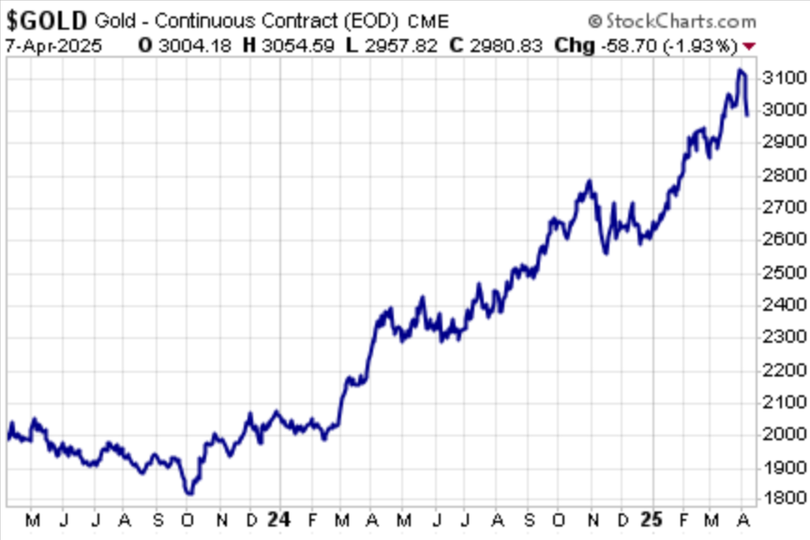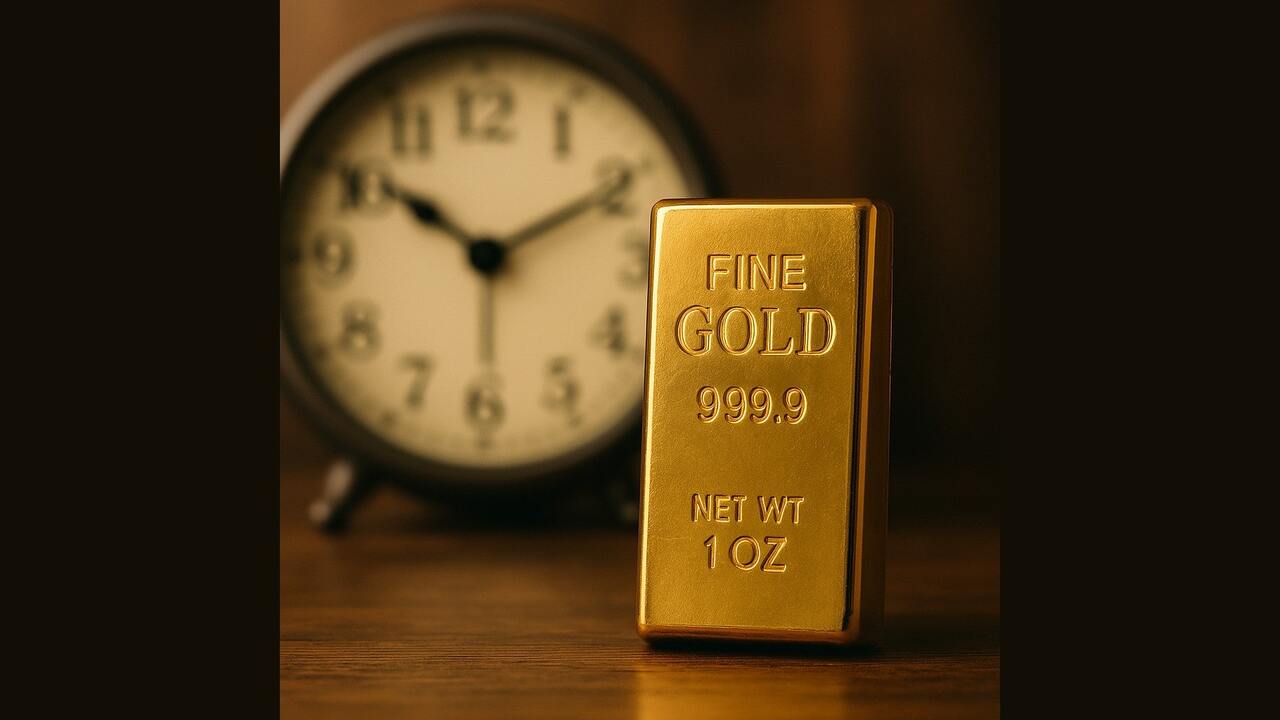(Doug Horning, Money Metals News Service) In order to determine why it isn’t too late to buy gold, we need to consider why many people might be inclined to think that it is too late.
First and foremost, gold has been on an explosive bull run, as you can see in the chart below. After being essentially flat for the first 3½ years of the 2020s—with strong resistance at $2,000/oz.—it took off for higher ground and hasn’t paused for breath since.
In March 2023, gold was priced at approximately $1,900 per troy ounce.
By March 2025, it had surged to around $3,038, marking an increase of 60%. It’s even higher ($3,125) as I write on April Fool’s Day. But it’s no joke. Gold handily trounced both the S&P 500 (+41%) and NASDAQ (+49%) over that same two-year period.

And it has been making higher and higher highs. Anyone could be forgiven for thinking that the bull must be nearing exhaustion by now.
But not so fast…
When you look at appreciation in gold (or any other asset), what you are always seeing is the gain in nominal terms. However, the proper way to view it is in inflation-adjusted terms.
Let me illustrate: what is the current buying power of the asset—in US dollars, assuming that’s your currency—vs. what it was when you acquired it?
- This is the true measure of something’s worth. Because inflation is a currency killer.
We haven’t had zero annual inflation since the 19th century, and the past 50 years have been particularly brutal. The dollar has declined 88% since 1971 (not coincidentally, the year President Nixon ended all convertibility of dollars into gold).
Now look at gold—a/k/a real money—in this light. In early 1980, its price peaked at $850/ounce. While it has far exceeded that benchmark in the interim, it has never done so inflation-adjusted. What $850 bought in 1980 would today require you to pony up a whopping $3,291.50.
In other words, despite its run-up, gold is still less expensive than it was 45 years ago! If you’d sequestered dollar bills under your mattress in 1980, each would now be worth about 12 cents. But any gold coins you saved would have lost no buying power. None.
Gold is, and has always been, the ultimate inflation hedge. Currencies get debased, and often become worthless. Gold never has.
Here are five drivers of the current gold demand, and hence the price:
- Geopolitical Drama – Wars, political change, and global instability. Chaos is gold’s love language.
- Dollar weakness/inflation – As noted, the two are intertwined. Looming also are challenges to the USD’s position as the global reserve currency.
- Stagnant supply – In 2023, about 3100 metric tons of gold were mined worldwide, a number that’s unchanged since 2014. It’s generally accepted that most of the monster deposits have already been found, and major new discoveries are rare. As it becomes ever more difficult to mine the metal economically, gold becomes scarcer.
- Money printing – The world’s central banks are all still creating new currency units like they were M&Ms.
- Central Banks Are Buying.
This last point is key and is worth expanding upon because central bank demand has been the primary impetus behind gold’s rapid rise in the past few years. This is a dramatic turnaround from 30 years ago.
Between 1995 and 2009, central banks were net sellers of gold, reducing their reserves. We may infer that they believed gold was no longer relevant. In 2010, they shifted to modest net buyers, with annual purchases averaging 473 tonnes (i.e., metric tons) through 2021. Then, for whatever reason, they experienced a significant attitude adjustment and engaged in really serious buying.
- In 2022, according to the World Gold Council, central banks made record net purchases of 1,082 tonnes, more than doubling the previous decade’s average. In 2023, the number was 1,037 tonnes, and last year it was 1,045 tonnes, the third consecutive year exceeding 1,000 tonnes.
One metric ton = 32,150 troy ounces, so we’re talking a LOT of gold.
Moreover, the published figures may be an underestimate, because of the opaque nature of the Chinese market. The People’s Bank of China (PBoC) officially reported purchasing just 44 tonnes of gold during 2024, despite a six-month pause between May and October. Yet China is the world’s #1 miner, accounting for approximately 10% of global production. That amounted to output of some 370 tonnes over the course of the year, and all of it remained somewhere in the country. How much the PBoC swallowed up remains a mystery.
The odd reality is that, while central banks have been pushing gold’s price up, there has not yet been much market participation by institutions and the general public. Jewelry sales are down. Individual investors seem to largely be in a state of FOJI (fear of joining in), frightened that they may be tardy to the party.
That will change, and when it does, FOMO (fear of missing out) will replace FOJI and the bulls will likely stampede.
All of that said, it’s unwise to treat gold as a speculative investment. It’s something to buy and hold, your insurance policy against the devaluation of the electronic ledger entries that now represent dollars. Is it too late to add gold to your assets? No. Never is.
- As a footnote, let me add that you shouldn’t be spooked by the recent tariff-induced price decline. Historically this always happens when there is a stock market crash. Traders who get caught short in their positions need to raise quick cash to cover their losses. It’s normal. And gold has always rebounded faster than stocks. If the drop may seem large at the moment, look back at the 2-year chart to see that it’s just a blip. You can wait for the dust to settle if you like, but pullbacks are invitations.
And if you are also looking for profitable investments in the gold market, consider the companies that mine the stuff. Most have yet to join in the metal’s bull run, and many are literally dirt cheap, as Jeff has pointed out. Historically, mining shares always lag physical bullion, but eventually, they always break out. When they do, their returns tend to be many multiples of further gold price appreciation. That’s why we’re aggressively investing now, check it all out here.
Originally published on The Gold Advisor.
To get Jeff Clark’s ongoing commentary on the markets, click here to subscribe to his FREE Gold Advisor and Silver Advisor email newsletters.

